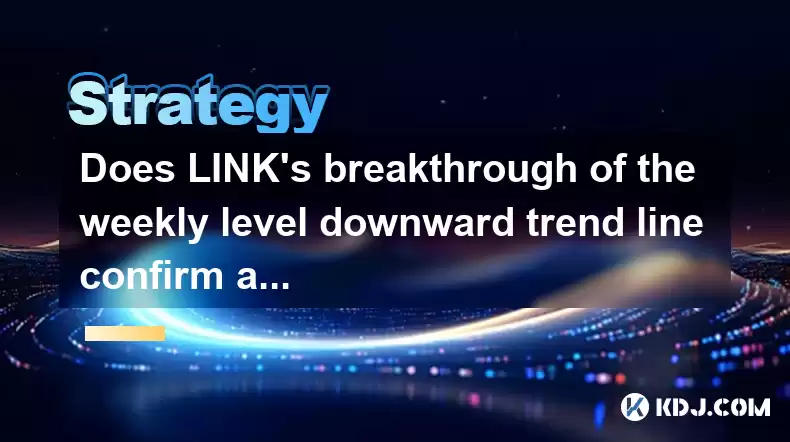-
 bitcoin
bitcoin $110918.433029 USD
-1.69% -
 ethereum
ethereum $3996.872473 USD
-2.43% -
 tether
tether $1.000594 USD
0.00% -
 bnb
bnb $1178.871834 USD
-2.38% -
 xrp
xrp $2.413973 USD
-3.47% -
 solana
solana $194.341461 USD
-4.24% -
 usd-coin
usd-coin $0.999963 USD
-0.03% -
 tron
tron $0.320092 USD
0.92% -
 dogecoin
dogecoin $0.196919 USD
-3.42% -
 cardano
cardano $0.669585 USD
-3.63% -
 hyperliquid
hyperliquid $37.485952 USD
-3.58% -
 ethena-usde
ethena-usde $1.000026 USD
-0.02% -
 chainlink
chainlink $18.018220 USD
-5.13% -
 bitcoin-cash
bitcoin-cash $523.879267 USD
-2.41% -
 stellar
stellar $0.324655 USD
-3.67%
Does LINK's breakthrough of the weekly level downward trend line confirm a reversal?
LINK's breakthrough of the weekly downward trend line suggests a potential reversal, but confirmation from volume, price action, and other indicators is crucial.
Apr 27, 2025 at 09:56 am

The cryptocurrency market is filled with technical analysis enthusiasts who constantly seek to understand the potential direction of various assets. One such asset that has garnered significant attention is Chainlink (LINK). A key question that many investors and traders are asking is whether LINK's breakthrough of the weekly level downward trend line confirms a reversal. To address this question, we need to delve into the technical aspects of LINK's price movements, understand the significance of trend lines, and analyze other relevant indicators.
Understanding Trend Lines in Cryptocurrency
Trend lines are a fundamental tool in technical analysis used to identify the direction of a price movement. They are drawn by connecting a series of highs or lows on a price chart. In the case of LINK, a downward trend line would be drawn by connecting successive lower highs, indicating a bearish trend. Conversely, an upward trend line would be drawn by connecting higher lows, suggesting a bullish trend.
When a price breaks through a trend line, it is often interpreted as a potential signal of a trend reversal. However, a single breakthrough does not necessarily confirm a reversal. It is crucial to look at other technical indicators and market conditions to validate such a move.
LINK's Weekly Level Downward Trend Line Breakthrough
In recent weeks, LINK has indeed broken through its weekly level downward trend line. This event has sparked interest and debate within the crypto community. To understand the implications of this breakthrough, we need to examine the specifics of the trend line and the context in which the breakthrough occurred.
The Trend Line's Duration and Strength: The longer a trend line has been in place and the more times it has been tested, the more significant its breakthrough becomes. If LINK's downward trend line was in place for several months and had been touched multiple times, its recent breakthrough would carry more weight.
Volume and Price Action: A valid breakout is often accompanied by increased trading volume. If LINK's price broke through the trend line with significant volume, it would lend credibility to the potential reversal. Additionally, the price action following the breakout should show continued strength and not immediately revert back below the trend line.
Other Technical Indicators: To confirm a reversal, it is beneficial to look at other technical indicators such as moving averages, the Relative Strength Index (RSI), and the Moving Average Convergence Divergence (MACD). If these indicators also suggest a bullish shift, the case for a reversal becomes stronger.
Analyzing LINK's Price Action Post-Breakthrough
Following the breakthrough of the weekly level downward trend line, it is essential to analyze LINK's price action to determine if the move is sustainable. Here are some key points to consider:
Price Retracement: After breaking through a trend line, it is common for the price to experience a retracement. If LINK's price retraces but holds above the broken trend line, it could indicate that the breakout is valid and that buyers are stepping in to support the new higher levels.
Subsequent Highs and Lows: If LINK forms higher highs and higher lows after the breakout, it would further support the notion of a bullish reversal. Conversely, if the price fails to establish new higher highs and instead forms lower lows, it may suggest that the breakout was a false signal.
Market Sentiment and News: External factors such as market sentiment and news related to Chainlink can also influence the validity of the breakout. Positive developments or partnerships announced by Chainlink could bolster the case for a sustained reversal.
Other Indicators to Consider
While the breakthrough of a trend line is significant, it is just one piece of the puzzle. To gain a more comprehensive understanding, it is helpful to consider other technical indicators that might corroborate or contradict the potential reversal signal.
Moving Averages: If LINK's price is trading above key moving averages such as the 50-day or 200-day moving average, it could indicate that the bulls are in control. Conversely, if the price remains below these averages, it might suggest that the bearish trend is still intact.
Relative Strength Index (RSI): The RSI is a momentum oscillator that measures the speed and change of price movements. If the RSI is moving above 50 and showing bullish divergence, it could support the case for a reversal.
Moving Average Convergence Divergence (MACD): The MACD is another momentum indicator that can help confirm trend reversals. If the MACD line crosses above the signal line and the histogram starts to show positive values, it could indicate that bullish momentum is building.
The Importance of Confirmation and Patience
In the world of cryptocurrency trading, patience and confirmation are key. While LINK's breakthrough of the weekly level downward trend line is a positive sign, it is crucial to wait for additional confirmation before concluding that a reversal has occurred. Traders should consider using a combination of technical indicators and market analysis to validate the breakout.
Multiple Timeframe Analysis: Analyzing LINK's price action across different timeframes can provide a more holistic view. If the breakout is confirmed on both shorter and longer timeframes, it increases the likelihood of a genuine reversal.
Risk Management: Even if the evidence suggests a reversal, it is essential to implement proper risk management strategies. Setting stop-loss orders below the broken trend line can help protect against the possibility of a false breakout.
Market Context: The broader market context should also be considered. If the overall cryptocurrency market is experiencing a bullish trend, it could provide additional support for LINK's potential reversal.
Frequently Asked Questions
Q: How long should I wait for confirmation after a trend line breakthrough?A: The time frame for confirmation can vary, but as a general rule, it is advisable to wait for at least a few weeks to see if the price action continues to support the breakout. Monitoring the price action over several candlesticks on the weekly chart can provide a clearer picture.
Q: Can a trend line breakthrough be a false signal?A: Yes, trend line breakthroughs can indeed be false signals. This is why it is crucial to look for additional confirmation from other technical indicators and market conditions. A false breakout often sees the price quickly revert back below the trend line, accompanied by low volume.
Q: What other factors should I consider when analyzing LINK's potential reversal?A: In addition to technical indicators, it is important to consider fundamental factors such as Chainlink's partnerships, technological developments, and overall market sentiment towards the project. These elements can significantly impact the sustainability of any price movement.
Q: Is it safe to enter a trade immediately after a trend line breakthrough?A: It is generally not recommended to enter a trade immediately after a trend line breakthrough without additional confirmation. Waiting for other indicators to align and for the price action to demonstrate continued strength can help reduce the risk of entering a false breakout.
Disclaimer:info@kdj.com
The information provided is not trading advice. kdj.com does not assume any responsibility for any investments made based on the information provided in this article. Cryptocurrencies are highly volatile and it is highly recommended that you invest with caution after thorough research!
If you believe that the content used on this website infringes your copyright, please contact us immediately (info@kdj.com) and we will delete it promptly.
- DOGE, AlphaPepe, and the Crypto Explosion: What's Next?
- 2025-10-17 04:25:14
- Dogecoin, Bitcoin, and Ethereum: Navigating the Crypto Current
- 2025-10-17 04:25:14
- Dogecoin, Shiba Inu, and Remittix: Meme Coins vs. Real Utility
- 2025-10-17 05:05:14
- Toncoin's Next Move: Catalysts and Considerations for Investors
- 2025-10-17 05:05:14
- KGeN Token's Wild Ride: Price Surge, Plunge, and What It Means for Crypto
- 2025-10-17 05:10:01
- Coinbase, Altcoins, and DeepSnitch AI: Navigating the Crypto Landscape
- 2025-10-17 04:45:14
Related knowledge

Practical parameter settings for a Bitcoin multi-timeframe moving average system
Sep 18,2025 at 10:54pm
Optimizing Timeframe Combinations for Bitcoin Trading1. Selecting appropriate timeframes is crucial when building a multi-timeframe moving average sys...

How can I filter out false breakouts in Dogecoin high-frequency trading?
Sep 22,2025 at 01:00am
Understanding False Breakouts in Dogecoin Trading1. A false breakout occurs when Dogecoin's price appears to move beyond a defined support or resistan...

Techniques for identifying tops and bottoms in the Bitcoin on-chain NVT model
Sep 20,2025 at 07:54pm
Understanding the NVT Model in Bitcoin Analysis1. The Network Value to Transactions (NVT) ratio is often described as the 'P/E ratio' of the cryptocur...

What does the surge in open interest in Bitcoincoin futures mean?
Sep 20,2025 at 11:18pm
Understanding the Surge in Dogecoin Futures Open Interest1. A surge in open interest within Dogecoin futures indicates a growing number of active cont...

How can I use the Ethereum USDT premium to gauge market sentiment?
Sep 18,2025 at 11:55pm
Understanding the Ethereum USDT Premium1. The Ethereum USDT premium refers to the price difference between USDT (Tether) traded on Ethereum-based plat...

What should I do if Ethereum staking yields decline?
Sep 20,2025 at 06:18am
Understanding the Causes Behind Declining Ethereum Staking Yields1. The Ethereum network transitioned to a proof-of-stake consensus mechanism with the...

Practical parameter settings for a Bitcoin multi-timeframe moving average system
Sep 18,2025 at 10:54pm
Optimizing Timeframe Combinations for Bitcoin Trading1. Selecting appropriate timeframes is crucial when building a multi-timeframe moving average sys...

How can I filter out false breakouts in Dogecoin high-frequency trading?
Sep 22,2025 at 01:00am
Understanding False Breakouts in Dogecoin Trading1. A false breakout occurs when Dogecoin's price appears to move beyond a defined support or resistan...

Techniques for identifying tops and bottoms in the Bitcoin on-chain NVT model
Sep 20,2025 at 07:54pm
Understanding the NVT Model in Bitcoin Analysis1. The Network Value to Transactions (NVT) ratio is often described as the 'P/E ratio' of the cryptocur...

What does the surge in open interest in Bitcoincoin futures mean?
Sep 20,2025 at 11:18pm
Understanding the Surge in Dogecoin Futures Open Interest1. A surge in open interest within Dogecoin futures indicates a growing number of active cont...

How can I use the Ethereum USDT premium to gauge market sentiment?
Sep 18,2025 at 11:55pm
Understanding the Ethereum USDT Premium1. The Ethereum USDT premium refers to the price difference between USDT (Tether) traded on Ethereum-based plat...

What should I do if Ethereum staking yields decline?
Sep 20,2025 at 06:18am
Understanding the Causes Behind Declining Ethereum Staking Yields1. The Ethereum network transitioned to a proof-of-stake consensus mechanism with the...
See all articles










































































